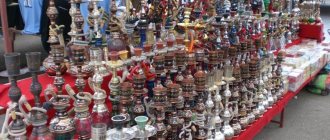Black gold is a metal that has been gaining popularity in recent years. Jewelry of this shade is in demand. Jewelers say that blackened gold is a godsend for jewelry designers. It has a lot of positive qualities and, despite the cost, always finds buyers.
Black gold ring with stones
How do you get it?
Color can be achieved in three ways:
- Chromium, cobalt and sulfur are added to the alloy.
- Covered with a layer of rhodium.
- Using amorphous carbon.
Chromium and cobalt are present in the alloy in the amount of 25%, so jewelry of this color has a purity of 750. If this is not enough, then the alloy is processed; it undergoes oxidation at high temperatures.
Characteristics of the components of the ligature:
- Cobalt is a silver-colored element with a yellowish or bluish tint. Durable, oxidizes at temperatures above 300 degrees.
- Chrome is a hard element and has a blue or black tint. Amenable to mechanical action.
- Sulfur acts as an additional material; it is capable of creating compounds with carbon and other elements.
By adding these materials to the alloy, the alloy becomes durable, practical and acquires the desired shade.
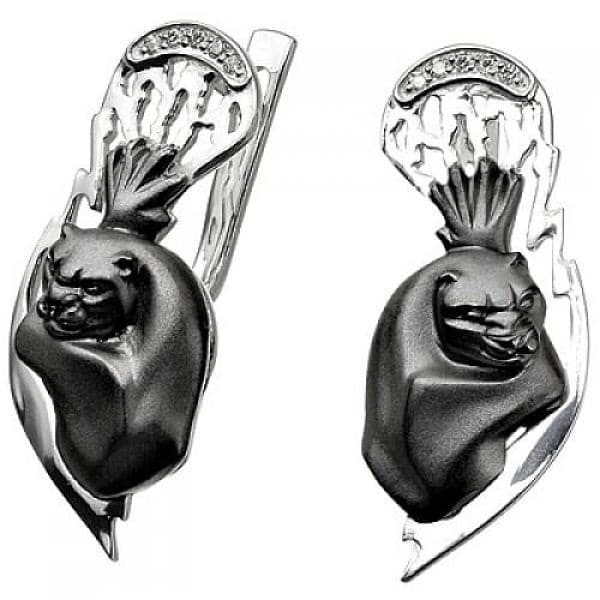
Earrings made of white and black gold
Jewelry is coated with rhodium, a process called rhodium plating. As a result, a film is formed on the surface of the product, which protects against damage and adds color. Rhodium plating is a complex process; the surface of the metal can be coated not only with rhodium, but also with amorphous carbon.
When rhodium plating, the master can control the process of changing the color of the jewelry. The product receives a shade from gray to black. Today, laser technology is used to make such jewelry.
Where can I buy or sell?
The safest option would be to purchase jewelry from a large store. Here, before purchasing, you can study the passport and certificate, and also carefully examine the product. There is a larger selection of jewelry in online stores, but the risk of buying a fake increases. It will not be easy to exchange such a product.
Black gold products are produced not only by large factories, but also by small workshops. Unique jewelry can be found on Internet resources such as “Masters' Fair”.
At lower prices, you can find used jewelry in pawn shops and among private advertisements. In this case, the authenticity of the goods remains on the conscience of the seller. The cost of products often speaks volumes about their quality. It is affected by the following parameters:
- rhodium plating has a lower cost than manufacturing a complex alloy;
- the cost of a gram of pure gold, established by the Central Bank;
- gold content;
- the presence of inserts made of precious stones, pearls, and other alloys;
- product exclusivity;
- place of production, delivery, transportation costs.
How much is 1 gram of black gold worth today?
I suggest you familiarize yourself with the current price for products made of blackened precious metal:
| Price 999 standard according to the Central Bank | Market value of the sample today | Scrap price | Price in jewelry |
Benefits of Jewelry
The rhodium plating process gives the ligature:
- Strength.
- Wear resistance.
- Color.
Blackening of gold gives the metal strength and ductility. Even products of high standard retain all the qualities of yellow metal and at the same time have good strength.
Rhodium plating improves wear resistance. As a result, the jewelry does not oxidize; the film that covers the surface of the product protects it from environmental factors and reagents.
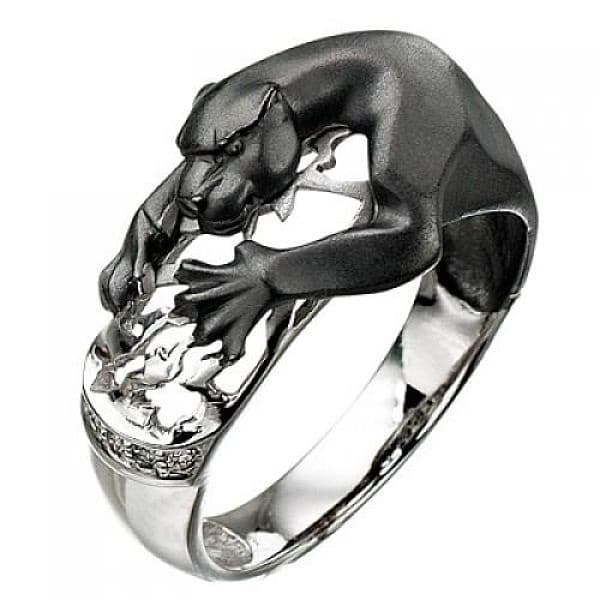
Panther ring in white and black gold
Color is one of the advantages; Along with white, rose and yellow gold, black retains its uniqueness due to its hue. Jewelry of this color goes well with business suits and luxurious outfits.
In addition, metal is combined with the following stones:
- opal;
- emerald;
- ruby;
- diamond.
Jewelers treated ferrous metal with caution; the reason for this was the stones with which jewelry was encrusted. If platinum and gold hide the flaws of stones, then black gold can show them off. Therefore, for a long time, products were decorated only with black diamonds.
But recently you can find jewelry inlaid with other stones on store shelves, and it turned out that this combination is no worse. The stones not only delight with their shine, but also match the texture of metal.
But a wedding ring made of this metal is considered a classic. It represents the direction of minimalism and does not require inlay with stones.
Black gold jewelry is complemented with one stone, this is quite enough.
Combination with stones
Blackened precious metal is often combined with a variety of stones and pearls. Its main feature is that any insertion errors are noticeable in such jewelry. The black color contrasts with scratches, asymmetry and chips. The craftsman needs to carefully examine the stone, otherwise the item will lose its presentable appearance.
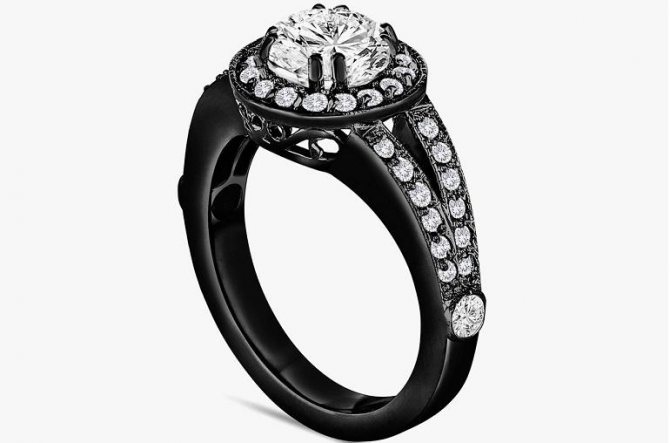
At first, the blackened precious metal was combined only with black pearls and dark diamonds. Nowadays you can find jewelry with almost any stones and pearls on sale. Jewelers in China prefer to use a scattering of inserts of different colors, creating spectacular contrasting luxury items.
A brief history of the Arabian Peninsula in the first half of the twentieth century.
The territory of the Arabian Peninsula covers more than 2,590,000 square kilometers. It is surrounded on the west by the Red Sea, on the south by the Arabian Sea, and on the east by the Arabian Gulf, also known as the Persian Gulf. The landscape of the peninsula in the first half of the twentieth century consisted of vast, harsh and barren deserts and ports located on the shores, which made their countries at least somewhat inhabitable. Arabia was divided into three main parts:
1) Hijaz in the west, extending from the Persian Gulf north to the border with Yemen. The Muslim holy cities of Mecca and Medina are located in the south of the Hijaz.
2) Najd, occupied central part of the peninsula
3) Rub al-Khali, better known as 'Empty Quarter' - an area in the center of the southern part of the peninsula. The world's largest desert with several inhabitants and 37 known animal species.
The Arabian Peninsula was inhabited by Arab tribes, also known as "Bedouins", who lived in these lands for centuries and were, for the most part, nomads. However, several communities, known as Hadar, were located in coastal cities under construction. Tribal unions were made up of family groups and could have hundreds or even thousands of members, but each of the tribal unions was divided into smaller groups. The survival of the tribes and their control over parts of the Arabian Peninsula was determined by tribal alliances that changed frequently over time.
The members of the Arabian tribes, they claimed, were descended from two ancestors: Adnan and Qahtan. According to beliefs, the northern tribes were the descendants of Adnan, one of the sons of Ismail, and the southern ones were the descendants of Qahtan, one of the sons of Noah.
In the first half of the 20th century, there were several significant tribes controlling different parts of the Arabian Peninsula. They were called Aniza, Ajman, Shmmar, Narb, Mustir, Bani Yas, Sibay, Quawasim, Banu Yam, Zaab and Banu Tamim.
Abdul Aziz ibn Saud, the founder of the Kingdom of Saudi Arabia, came from the Anisa tribe, which originated in the Najd region. The Al-Thani family, which ruled Qatar, came from the Banu Tamim tribe, which originated in Central Arabia and came to Qatar in the 17th century. The main tribe of the northeastern region was the Ajman tribe, living mostly in the Hasa region, Kuwait and Muntafika in Iraq. The Harb tribe appeared in the region during the time of the Prophet Muhammad, and the Bani Yas tribe lived in the lands of the Abu Dhabi and Dubai region. Founder of U.A.E. Sheikh Zayed ibn Sultan an-Nahyan came from the Bani Yas tribe.
The political landscape of the Arabian Peninsula in the first half of the 20th century featured self-governing Arab tribes largely dependent on the Turks, who ruled the Arabian Peninsula until 1922, when the Ottoman Empire fell and Britain formed an alliance with the Arab tribes. The Ottoman Empire formally ended in 1923 with the signing of the Treaty of Lausanne.
Today, the Arabian Peninsula is divided into seven independent states: the Kingdom of Saudi Arabia, Qatar, Bahrain, Kuwait, the United Arab Emirates, Oman and Jordan.
Reviews
Svetlana: I’ve been wearing a black gold ring for several years now. It looks unusual and attracts attention. Over the course of three years, almost imperceptible scratches appeared on it. I bought it in Moscow at the Diamonds are Forever store.
Yana: I used to see white and green gold, but I didn’t know whether it came in black. One day I saw earrings on the official website of American, couldn’t resist and ordered them. The jewelry is simply magnificent, it looks just like in the photo: voluminous, with a scattering of multi-colored stones. They didn't cheat with the size either. There is no hallmark on them, only a factory imprint, but this doesn’t bother me much, because I took them for myself. And they look simply amazing.
Black gold jewelry is unusual and spectacular. Contrasting combinations of black precious metal with yellow and white gold and multi-colored stones are attracting more and more fans.
If the information was interesting to you, do not forget to share it on social networks.
Recommendations for care, cleaning and storage
Jewelry made from black precious metal is quite durable. However, if used improperly, scratches and abrasions may remain on their surface, which will significantly damage the appearance of the products. I offer recommendations that will allow you to preserve your jewelry:
- It is better to remove jewelry during contact with water or physical activity;
- do not expose products to aggressive cleaning agents;
- store jewelry in cases, with small parts and links straightened, avoid creases;
- do not leave products for a long time in rooms with high humidity;
- Clean in soapy water and rub gold jewelry only with a soft cloth, suede, do not use brushes.
Visuals of “Black Gold”
Black Gold was filmed on location in the stunning landscapes of Tauzar, the mountainous terrain of Matmara, the oasis of Chebika and around Hammamet in Tunisia, as well as the breathtaking sand dunes of Umm Said in Qatar.
Throughout filming, the filmmakers drew inspiration from 19th-century Orientalist paintings created by European artists traveling through North Africa and the Middle East. Europeans captured the sights and atmosphere of the seductive world that opened up to them: bazaars, markets, palaces, harems... Ironically, due to the restrictions on the visual arts imposed by Islam, it was these Orientalist drawings that ultimately turned out to be the best documentary evidence of life in the Arab region at that time .
“When I started traveling to countries like Yemen, Oman or Jordan,” says Annaud, “I was struck by how close the modern world is to what Delacroix, Fromentin or Zim once painted.”
Anno sought to create two contrasting worlds of the warring kingdoms of Salmaah and Hobeika.
Salmaah featured stone buildings, a mountain fortress for Sultan Amar and his family, and colorful costumes inspired by the Ottoman Empire. Hobeik, the kingdom of Emir Nasib, and its capital, were dominated by the style of the Central Arabian Peninsula and the influence of the recent British presence. This is why we often see the citizens of Hobeika wearing Western uniforms along with traditional white robes and turbans.
Perhaps this is why the kingdom of Hobeiki required the most spectacular scenery. Highly qualified Tunisian specialists and designers designed the scenery of the fortresses and ramparts in the southern Tunisian desert near Tawzar. They also built an entire Arabian city, with a main square and streets, at Empire Studios near the Tunisian city of Hammamet.
Built by Tarak Ben Ammar in 2000 to recreate the views of Ancient Rome, Empire Studios has been transformed into a magical world of Arab souks and palaces.
“I have acted in more than 80 films, including such large-scale projects as Zorro and Evita, but never in my life have I seen anything like the Hobeika set,” says Antonio Banderas. “They are incredibly beautiful. People want to visit this city! Every detail is so realistic... In such realistic settings it is much easier to forget about the camera. As an actor, you truly transform and become your character, living in a specific historical moment.”
“Creating a set is part of a long journey,” says Anno. “They primarily help the cast and crew get into the right frame of mind.”
Most of the location filming of Black Gold took place in the middle of the deserts of Qatar and Tunisia. This alone was a real challenge, not to mention working with a film crew consisting of hundreds of people, thousands of extras, a huge number of horses, camels and armored vehicles. Moreover, the filmmakers also had to deal with incredible weather conditions, such as heavy snowfall in the desert or flooding among the dunes. But all this pales in comparison to the powerful experience they unwittingly had during filming.
Revolution
On December 17, 2010 (somewhere around two months into filming Black Gold), a young vegetable vendor named Mohamed Bouazizi committed self-immolation in the Tunisian city of Sidi Bouzid to protest his mistreatment by local police and the hopeless situation in the country. . For several days, Bouazizi desperately fought for life in a hospital bed. His entire badly burned body was wrapped in bandages. He died two weeks later, on January 4, 2010. Bouazizi's act of self-immolation was an act of desperation calling for change in society. He could hardly have imagined that after his death he would become a symbol of historical and fateful changes for the youth of Tunisia and the entire Arab world.
The first wave of protests swept across the country immediately after Bouazizi's case became public. Tunisian authorities tried to brutally suppress the protests. They shot demonstrators and killed dozens of people. After it became known that Bouazizi had died from his burns, protests broke out like wildfire throughout Touris and turned into a real popular uprising. People demanded freedom, self-respect and work. The mood of the “Jasmine Revolution,” as it later became known throughout the world, was in the air. And only a few of those who were involved in the filming of “Black Gold” could have imagined that they would witness History that would be created right before their eyes.
“It was hard to believe what was happening here, things were moving so quickly,” says Antonio Banderas. “What struck us most was the strength and courage of the Tunisian people who took to the streets to fight for a better future even in the face of repression.”
Thanks to the many Tunisians who worked on the set of Black Gold, information about the rapidly spreading revolution was updated every minute. What began as local protests over the tragic circumstances of the death of one young man turned into a national revolution, essentially calling for the resignation of then-President Zine El Abidine Ben Ali, who ruled the country for 20 years.
For Tarak Ben Ammar, whose uncle Habib Bourguiba was the first president of independent Tunisia, the start of the revolution was both inspiring and frightening, since he was responsible for the safety of the crew and actors.
“I have always been optimistic about my fellow countrymen, and never thought that our country could slide into civil war or chaos. We are civilized, educated people,” says Ben Ammar. “I saw how the Tunisian members of my film crew and the extras of our guests whom we invited to participate in the film were guarded. The population of the villages around Empire Studios in Hammamet, where we were filming at the time, came to protect us. It was an amazing moment for the foreign actors and for their Tunisian colleagues, who united and became one family.”
Thanks to the events of the Jasmine Revolution, an extraordinary sense of community emerged between foreign and Tunisian actors and crew members. Moreover, the events that played out in front of them were strikingly similar to those that unfolded in the film. Just as in the Black Gold scenario, in real life young people overthrew the corrupt, myopic politicians of the older generation. Suddenly, a film set in the past seemed prophetic.
“Who can foresee that the Arab revolution will begin? History always turns out to be closer to reality than the wildest assumptions of politicians,” says Ben Ammar. “The events that unfolded before our eyes became a true inspiration for the actors. The actors witnessed important events in Arab history - and at the same time starred in a film about a key moment in the life of the Arabian Peninsula. About that period when the emirs had to look for answers to questions related to oil, Islam and the presence of foreigners. We were filming the scene where Nassib gives up the throne to his son-in-law just days after Ben Ali steps down. That was incredible. I think the audience will also feel something extraordinary.”
Perhaps almost as remarkable as the events that unfolded in Tunisia in those hot days of early January was the filming itself, which remained as indifferent to what was happening around it (except for ending a couple of hours earlier due to the curfew). This became possible primarily thanks to the incredible professionalism of the Tunisians from the film crew. They continued to show up for work on time and were able to concentrate on filming despite the growing unrest in their country.
“Even on January 17, when former President Ben Ali fled the country, we had a normal shooting day,” recalls Jean-Jacques Annaud. “Tunisia has a long, very long tradition of welcoming foreigners. Tunisia was a country of trade, and as a result, people from other countries were perceived as friends and potential customers. I think it's quite remarkable because people demanding change was one of the themes of our film."
The sense of camaraderie that developed between Tunisians and foreign cast members was so strong that large numbers of foreigners remained in Tunisia even after demonstrations across the country led to Zine El Abidine Ben Ali's flight to Saudi Arabia on 17 January. Jean-Jacques Annaud and Freida Pinto remained in Tunisia until the foreign members of the film crew were evacuated home.
“Our film and the revolution developed in parallel. It’s very rare to get the chance to witness such important events in history,” says Freida Pinto. “When I was asked to leave, I said that I would not do this under any circumstances. If something similar happened in India, if there was a revolution that would allow the flower of the nation to unite against corruption, I would also want to take part in it. I know a lot of people who were jealous of me for staying. I'm happy I was there."
Ultimately, the film's production was only delayed by four days in Tunisia due to the revolution, and all cast and crew members returned after Ben Ali's defection to complete planned scenes. The last day of filming in Tunisia was a very emotional experience for everyone, considering what the crew had to endure during those four months.
“I felt like I was in the right place at the right time,” says Tahar Rahim. “I felt something so strong that I can’t even express it in words. I saw people regaining their self-respect and winning their freedom.”
The Black Gold team has now moved to Qatar for the final four weeks of filming. New challenges awaited them there.
Sophisticated living and dining area
It's tempting to stay away from very light and very dark colors in your living room, using a neutral backdrop that allows you to switch between trendy accents as the seasons change. But let's look at those who have chosen a bold path to create a stunning, stylish living space, revealing deep black, taking gold as a shade.
Modern living and dining rooms in black look great with gold accents such as lamps and furniture. Lighting plays a very important role and you can use ambient and directional lighting to transform a room into a trendy indoor salon.

Zebra print rug, black background with gold accents
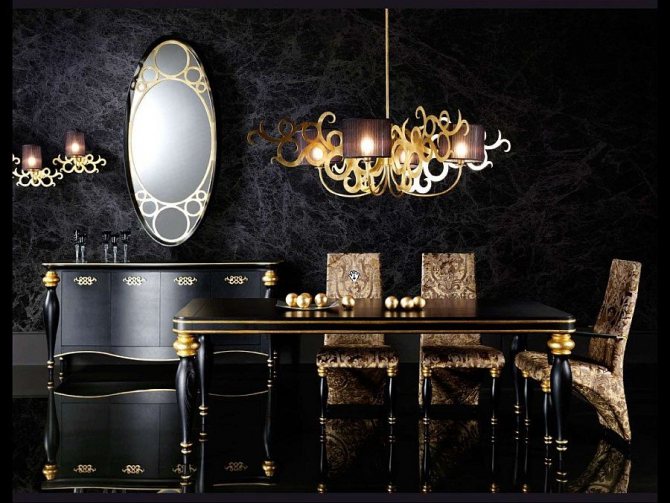
Stunning dining room in black with hints of gold

Gold colored ceiling adds luxury to the living room

Black and gold combined with beige
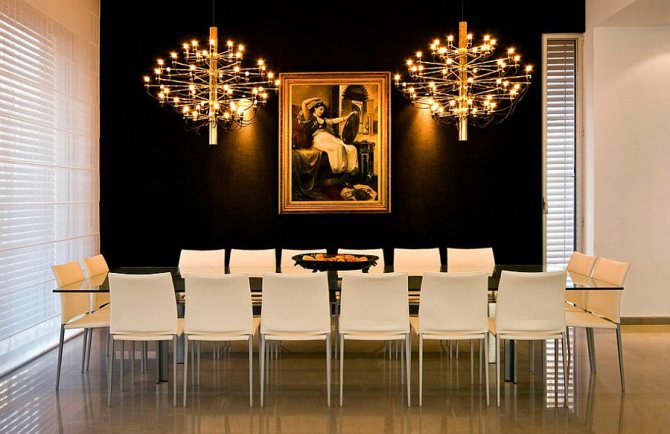
Luxury gold wall sconces on black wall background
